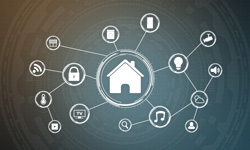Connected Homes for Improved Health and Lower Costs June 2019
Want more free featured content?
Subscribe to Insights in Brief

The connected home is becoming increasingly convenient for monitoring and improving occupants' health. For example, in April 2019, Amazon.com announced the first HIPAA- (Health Insurance Portability and Accountability Act 1996–) compliant skills for its Alexa smart assistant. Alexa users can now add HIPAA-compliant skills, enabling the smart assistant to transmit and receive protected health information. One such skill—Livongo—enables the user to query his or her most recent blood-sugar data and receive personalized health nudges and insights. Six HIPAA-compliant health-care skills exist currently, but Amazon has announced it intends to extend access to more developers in the near future.
Significant potential also exists to leverage household objects to gather data about users. Doing so can provide insights into the users' health state and track changes over time. For example, in 2018, Google filed a patent that describes using optical sensors to monitor and track changes in an individual's appearance to help reduce the risk of heart disease. Elsewhere, researchers at NeuraMetrix have developed a method to diagnose early symptoms of neurodegenerative diseases such as Huntington's and Alzheimer's from a keyboard-user's typing cadence. These examples demonstrate how data from household devices can provide early indications of serious diseases.
Implications
By enabling more devices to gather data about users, the connected home can enable more personalized and accurate health insights. As demand for personalized health care increases, demand for health-related smart home technologies is likely to increase too. Demand for these technologies is likely to be further compounded by the aging populations of many developed countries, such as the United States, South Korea, and Japan.
Manufacturers must overcome compatibility issues in order to capitalize on the full potential of health-related data. For example, data from a computer keyboard are unlikely alone to provide a complete view of the user's health status. However, if data from the keyboard can integrate with data from several other devices, this larger data set is likely to provide a coherent and comprehensive picture of the user's health—especially if these data are processed by machine-learning algorithms trained on data from thousands of other connected homes.
However, the personal nature of health and medical information raises potential privacy concerns for consumers. Enabling devices to access private medical information increases the possibility of headline-grabbing data breaches that may hinder adoption. Further, consumers may be wary of adopting smart-home technologies that enable such granular data gathering as to record their every move at home.
Impacts/Disruptions
The connected home has the potential to disrupt health care in several ways. Data from Internet of Things (IoT) devices could enable early diagnosis of serious diseases, such as cancer, heart disease, and Alzheimer's, enabling earlier intervention and potentially halting disease progression. Such early interventions could potentially reduce health-care costs, because preventive interventions are often less costly than curative treatments. Health insurance is also likely to see effects: Not only will earlier intervention reduce health-care costs, but data from IoT devices could inform policy providers and enable more accurate risk calculation.